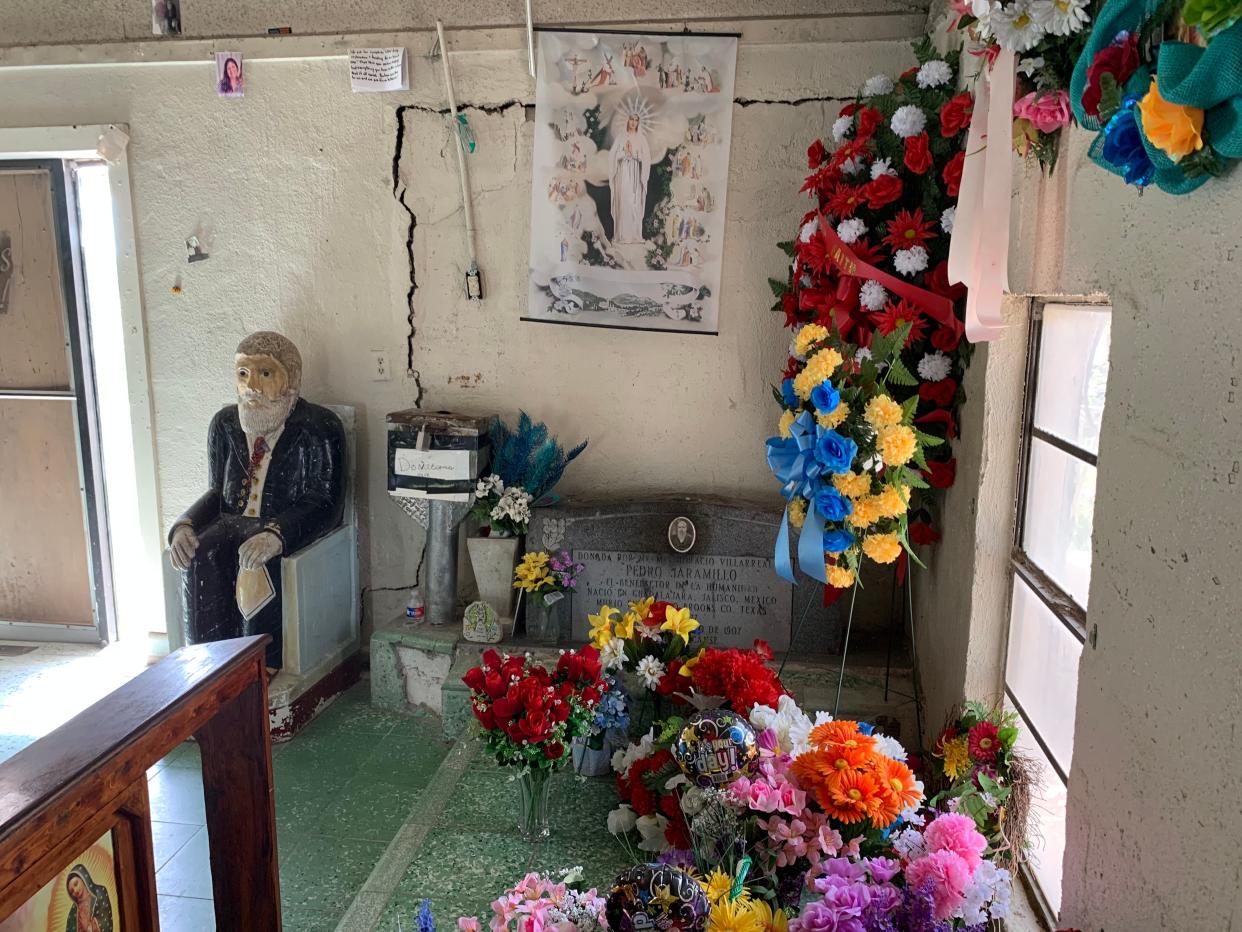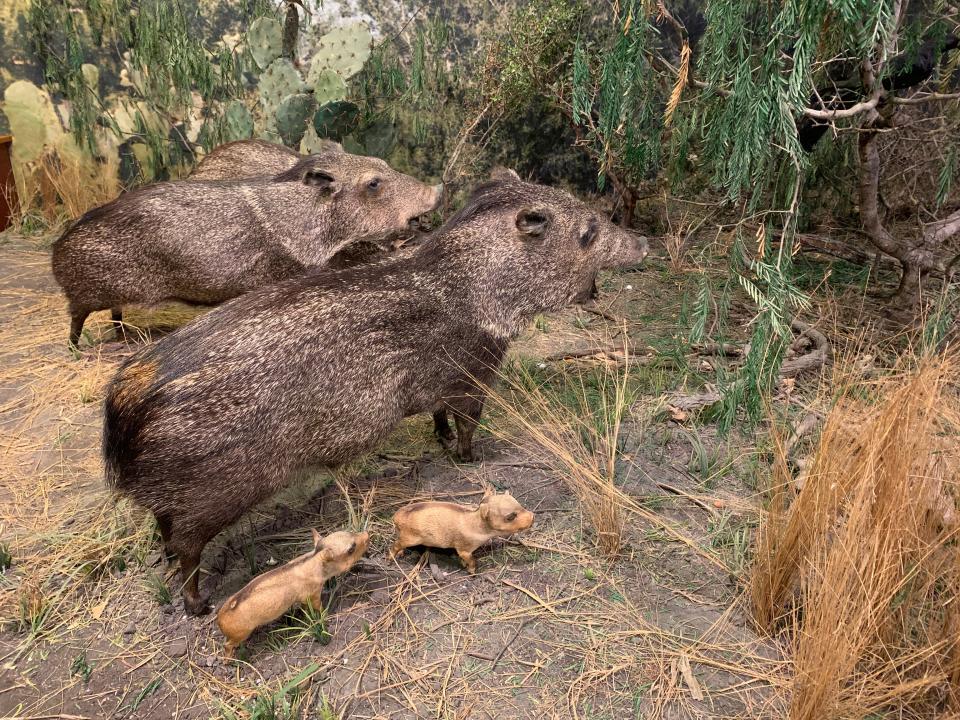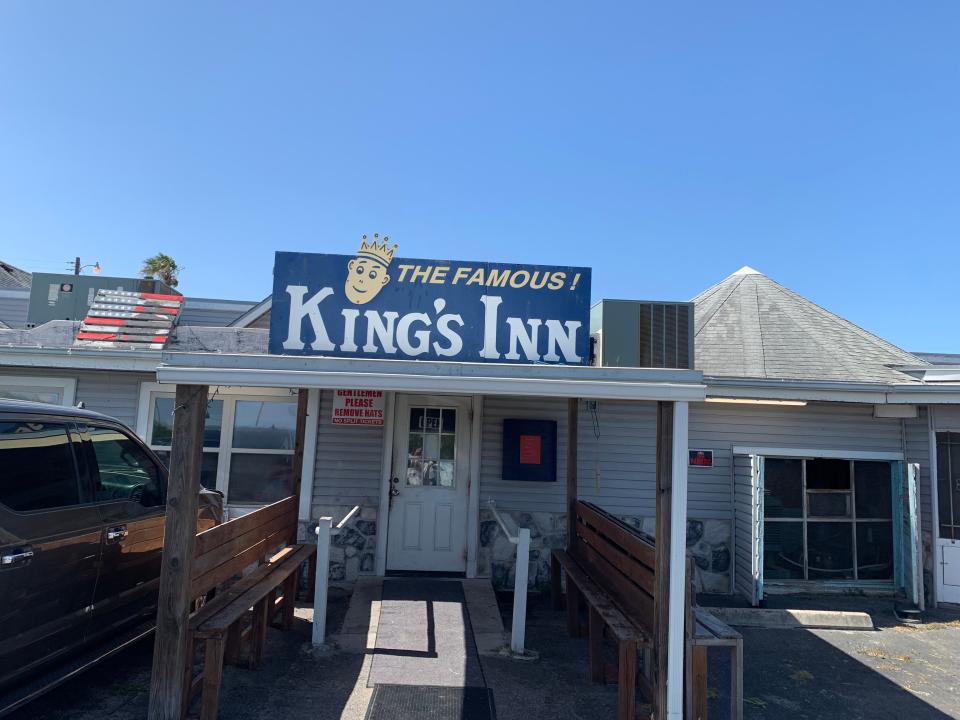Visiting shrines, missions, presidios, vaults and other hallowed places in South Texas

FALFURRIAS, TEXAS — Our recent road trip to South Texas did not end in Corpus Christi, although that auspicious city by the bay, described in last week's Think, Texas column, soaked up most of our time.
My travel buddy and I also took wide highways and narrow backroads across the mesquite scrubland and griddle-flat coastal plains to Falfurrias, Kingsville, Riviera and, on the way back to Austin, Goliad.
In retrospect, it resembled a medieval pilgrimage. In the cathedral town of Corpus, we visited several shrines, two churches, two cemeteries and one temple. Outside the city, we explored a healer's shrine, a mission, a presidio, two vaults of historical artifacts and a prime dining destination.
'Healer of Los Olmos' in Falfurrias
Of all the sacred places that we visited, the shrine to Don Pedro Jaramillo, "Healer of Los Olmos," made the most profound impression during our trip.
One must know where to look: Approaching Falfurrias from Riviera on U.S. 285, after passing vast fields of sorghum and cotton as well as pastureland, we zoomed by the ambiguously signed right turn onto FM 1418. We turned around, took the left, and headed north.
A few miles up the country road, we spied the shining shrine on the right.
It consists of two small, white-washed buildings and a family cemetery. The actual shrine contains the grave of Jaramillo, along with a saintly statue, an altar, religious artifacts and dozens of artificial flowers.
On the walls — and this gives one pause — are the pictures of stricken loved ones that pilgrims have attached to bulletin boards. Just imagine the sadness and seriousness of such a rite of devotion.
More: Here are 10 reasons why Corpus Christi is the most promising city in Texas
An Indigenous folk saint, Jaramillo was born in Guadalajara, Jalisco, and settled on the Los Olmos Ranch outside Falfurrias sometime near the turn of the last century. After curing himself and a few others of ailments, his fame among Mexican families in the region grew rapidly. People traveled great distances to obtain his help.
He died on July 3, 1907. His cures were collected in Spanish in 1934, then translated into English in 1951. For years, pilgrims camped on the banks of Los Olmos Creek to be close to Jamarillo's powers. He also fed the poor and was considered a seer.
Some of the structures on the land around the shrine indicate past social activity well beyond the shrine itself, but the remnants are now overgrown. A curio shop, however, continues to sell candles, herbs, books and other religious items. It was closed during our visit.
After the shrine, we dipped into Falfurrias, famous to Texans as the original home of Falfurrias Butter and associated with the King Ranch, as is everything in that part of the world. All that remains of the beloved dairy product in town — that we could find — is a sign on the former downtown creamery, which now houses the Falfurrias Facts newspaper.
You can still buy the ambrosial butter at H-E-B and elsewhere; it is now made at Keller's Creamery in Winnsboro.

Kingsville and the storied King Ranch
Kingsville is the gateway to the fabled King Ranch.
So it is not surprising that two of our stops in this tidy town of 25,000 were the King Ranch Museum, which offers an official view of that agricultural empire, and the Connor Museum on the campus of Texas A&M University Kingsville, which landed here in the 1920s and grew quickly, in part because of lobbying, planning and gifts from the extended King family.
First we stopped at the Kingsville Visitors Center, just off U.S. 77 on Corral Avenue. Two helpful guides helped me decide which of the King Ranch offerings to take. (With more time to plan, I would have booked one of the ranch's nature tours. This scrubland not far from the Rio Grande teams with flora and fauna not seen in the rest of the state.)
The King Ranch Museum, built inside a vaulting former ice factory, is on North Sixth Street not far from the center of town. The first thing that greets the visitor, as at most museums these days, is a gift shop. Yet this one is unusually large and sophisticated for a town museum.
My first clue.
More: Cityskates was popular spot for Corpus Christi's roller-skating crowd in ’90s
It soon became clear that this museum bore the official stamp of the King Ranch corporation, based in Houston. About half the space is given over to a handsome events center. The other is sumptuously outfitted with two floors of displays about racehorse breeding; Santa Gertrudis cattle, a sturdy stock crossbred on the ranch; and the far-ranging activities of the King, Kleberg and Armstrong family branches and other South Texas royalty.
The exhibits of saddles and other leatherwork would appeal to anyone; less so the vehicles, including a ranch-branded Ford F-150. I learned a good deal more about the family's history and about the Mexican immigrant workers known as Los Kineños. I admired the collections of historic firearms and ranch tools. Toni Frissell’s stunning photo essay of life on King Ranch in the early 1940s dominates many of the walls.
Yet while watching a short slick video and learning more about the King Ranch's global empire, the experience felt more promotional and less historical. Missing were some of the darker chapters in the ranch's history, which are well documented in dozens of books published on the ranching dominion.
More: Our Think, Texas road trip to Corpus Christi just got bigger. Too big for one visit.
The John E. Connor Museum, on the other hand, charmed me mainly because its site on the Texas A&M University Kingsville campus was not trying to sell me anything (ironically, I did buy one item there, which startled the small staff). Located in one of the college's older buildings on West Santa Gertrudis Street, the museum is neatly divided into a children's learning center and a natural history exhibit replete with game trophies and ecological dioramas.
My big purchase here ($22) was a book, "Texas A&M University Kingsville," by Cecilia Aros Hunter and Leslie Gene Hunter. Part of Arcadia Publishing's college history series, it is thoroughly researched and clearly written. I learned that the idea of planting a university in what seems to the visitor a remote part of Texas was deliberate and logical, because of Kingsville's central location in a triangle of land that stretches from the Rio Grande Valley to Corpus Christi and Victoria.
It was conceived as a "normal school" to train teachers, since Texas children were ill served in the early 20th century by country schools led by minimally prepared educators. Other normal schools that emerged from this movement in San Marcos, Denton, Canyon, Huntsville and Nacogdoches grew, like Kingsville's, into four-year institutions with broader responsibilities and sprawling campuses.
For most of my life, I knew Kingsville college as Texas A&I, one of its several names over the years. Its Javelinas sports teams always did well, and it seemed natural to me that the A&M system absorbed it, since much of the training in Kingsville had to do with agriculture, engineering, science and wildlife.
I learned a lot from this little 250-page book.

Riviera: Dining at the King's Inn
Virtually everyone who gave us South Texas travel advice in advance mentioned the King's Inn, an informal seafood eatery on Cayo de Grullo, an arm of Baffin Bay, that has attracted devoted fans since 1935.
Finding our way to the Inn was not a cinch. Printed and digital roadmaps were little help, and the turn from U.S. 77 to FM 628 just north of Riviera proper is not well signed. Once on FM 628, however, the trip — in daylight at least — is a snap. The road runs smack into the King's Inn's parking lot.
The low wooden structure rests on a rise above the bay. The dining rooms do not emphasize the view, however, but rather the food, served cheerfully and briskly by the pound and family-style. As you can imagine, the newcomer is tempted to over-order, but you won't be disappointed.
To give you sense of the place's allure, a family next to us in the waiting area had driven two hours from Laredo just for an early dinner.
More: Texas road trip: Tell us what to see, do and eat in Corpus Christi, and anywhere nearby
The salads are glorious. The seafood comes covered with golden breading, or not, your choice. My large, tender fried shrimp were easily the best I've had in ages. Don't skip the sides, including authentic onion rings, or dessert. Choose pie.
The table parties seemed split between mixed family gatherings and tight knots of people who had spent the day boating or fishing. My only complaint, a small one, had to do with the indifferent French fries. They could be elevated to the level of the other dishes.
Then again, why futz around? If the food ways have been working since 1935, something is right.
During our trip, we ate at several very good to excellent restaurants — Water Street Oyster Bar, Vietnam Restaurant, Elisabeth's (Mediterranean) and Hester's Café (pastries, soups, sandwiches) among them — in Corpus Christi. Yet this dining destination outside Riviera proved easily the most memorable.

Goliad: Well-done restoration
We hadn't planned to stop at the restored Presidio La Bahía, located across the San Antonio River from the town of Goliad. We were glad we did. Like other aspects of this joyful South Texas road trip, it was far more rewarding than I had remembered from earlier visits.
La Bahía is best known to many Texas history buffs as the fortifications involved in two signal events during the Texas Revolution. The spot was strategic, located halfway been the Presidio San Antonio de Béxar and the port of Copano on the Gulf Coast, on the Bahía branch of the Camino Real de los Tejas.
The first of two events was a 1835 skirmish during which the Texans overcame a small Mexican presence at the fort. The second was a massacre; 450 Texans under the leadership of James Fannin and William Ward were executed near and in the presidio under orders from General and President of Mexico Antonio Lopez de Santa Anna.
Hence during later battles, cries of "Remember Goliad!"
Yet La Bahía was much more than that. Originally planted nearer the coast to rebuff French incursions, the presidio and mission were moved several times.
More: 'We didn't let this place die': St. John Colony, Texas, endures for 150 years of grace
The permanent fort and church, planted here in 1749, rises on a high bluff above the San Antonio River. It played a role in several pre-revolutionary chapters of Texas history. While one can also visit the Fannin Memorial Monument, located not far away, the restored presidio and mission should in no way be missed.
Operated by the Catholic Diocese of Victoria, it includes a swell museum, crisply rendered limestone walls and batteries, soldiers' quarters, and Our Lady of Loretto Chapel, which radiates humble sanctity. Its groined vault goes back to the 18th century.
I find some of the other historical restorations in Texas a bit off-putting because the interpreters are not clear about what actually dates back to the Spanish era, and what was put up in the 20th century.
Not here. While based on meticulous research and inclusive of some original walls and buildings, the presidio restoration, placed over an 18th-century footprint, is clearly also something of our era, extremely well executed.
Michael Barnes writes about the people, places, culture and history of Austin and Texas. He can be reached at mbarnes@statesman.com.
This article originally appeared on Austin American-Statesman: Visiting shrines, missions, presidios and other South Texas spots.

